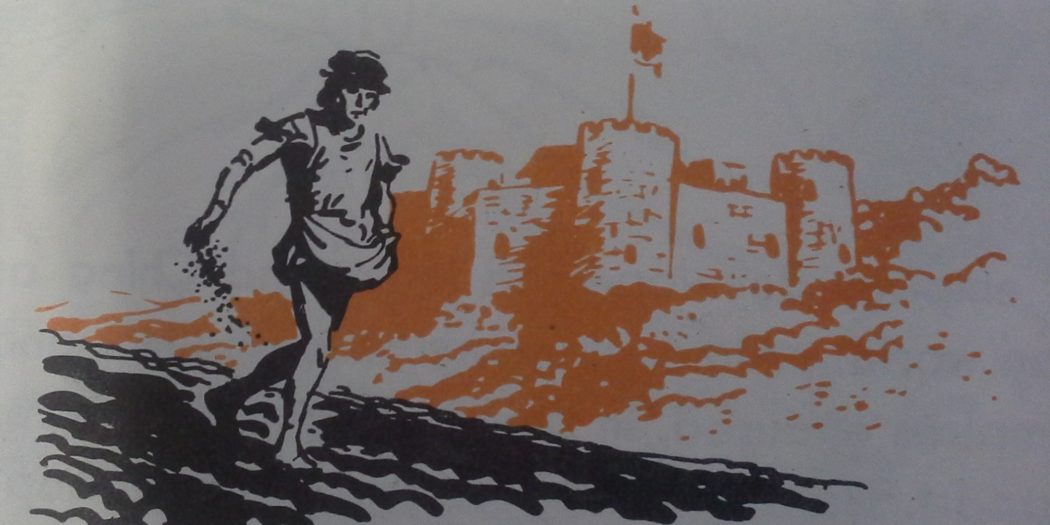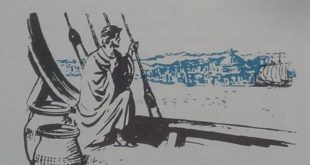The civilizations of India, China and the Moslem world progressed to about the year 1500 A.D., but what had been happening in western Europe in the centuries after Roman power began to decline and barbarian tribesmen had overrun the lands once part of the proud Roman Empire? What had taken the place of Roman might, government and law in western Europe?

As Rome’s rule faded away, western Europe entered a period known as the Middle Ages or the medieval period. For a long time there was neither a single empire nor nations as we know them to day. Central governments, such as there were, had little power. Warfare and violence were the rule rather than the exception. Bands of armed men roamed the countryside robbing and killing. Commerce dwindled from a stream to a mere trickle and cities diminished in number, size and importance. Men’s interest in art and learning became less and less. Only in the churches and monasteries where the men of God prayed and worked was there peace and learning. During the later Middle Ages forces were at work which were to bring about great changes in western Europe. For most people, however, the years from about 500 A.D. to 1300 A.D. were years of grinding toil on the little farms that encircled the villages. They were years of obedience to, and fear of, the grim armour clad fighting men who lived in the castles and manor houses dotting the countryside. They were years when the knowledge that had been developed by the Greeks and Romans was largely forgotten and the new learning of the Moslems was as yet little known. They were also years of ever growing religious faith. During that time the Catholic Church was not only the guardian of men’s consciences and souls; it was the strongest single organization of any kind in western Europe.
To understand more about Europe in the Middle Ages, we seek answers to the following questions:
1. What was life like in the Middle Ages?
2. Why did the feudal system develop?
3. What was the place of the Church in the Middle Ages?

1. What Was Life like in the Middle Ages?
Country life was dull and difficult in the Middle Ages. When you think of the Middle Ages, you may picture knights in shining armour riding spirited horses in tournaments before crowds of cheering onlookers. This, however, would be a one sided picture. It would be just as much of a mistake to think that most people in those days lived in turreted stone castles protected by water filled ditches. Colourful tournaments did take place and some people did live in great stone castles, but these fortunate persons were the few rich and powerful nobles, together with their families and households.
Most people in western Europe during the Middle Ages lived in huts which were clustered in small villages on large estates called manors. The manors were usually separated from one another by deep forests. Rarely did country people make a trip to the nearest town or to one of the few cities. In fact, most people born on a manor died there without ever going more than five or ten miles from home. Travel was both difficult and dangerous, for roads were poor, bridges were few and robbers were everywhere.
The people who lived in the tiny cottages spent their days struggling to obtain food enough to keep from being hungry and fuel enough to keep warm. Diseases, the causes of which were not understood, crippled or killed people in large numbers. Many children died in infancy. Warfare, starvation and cold added to the death toll. In contrast to the present day, therefore, western Europe in the Middle Ages was thinly settled and as if these grim dangers were not enough, there were always rents, fines and fees to be paid to the lord of the manor, usually in goods or work.
There were separate classes of people on the manor. Let us see in more detail what living was like on a manor in western Europe about the year 1000 A.D. We will for the moment imagine that you are living on a medieval manor. You are lucky, for you are neither a villein, a free man who pays rent for the right to use land on the manor for farming, nor a serf, a man who belongs to the manor. Instead, you are the son of the lord who; is master, landlord, chief lawmaker and judge on the manor.
You are the eldest of the lord’s sons, someday you yourself will be lord of this manor. You therefore pay close attention to the way your father and his helpers manage it. You learn that they must keep track of the sheep, cattle and pigs raised, of crops grown and of days of work put in by serfs and villeins. You also watch and listen carefully to what goes on when the manorial court meets. Your father presides over this gathering, where plans affecting the community are made and justice is handed out. A churchman, one of the few persons present who can write, keeps a record of the meetings and of decisions reached in disputes brought before the court.
Everyone on the manor contributes to the lord’s support. The court record clearly indicates the obligations of the people to the lord of the manor. For example, the court record says:
It is required of all the tenants of the manor that they heat up the oven, each of them when his turn shall come, under penalty of a fine.
This even, a dome shaped affair of stone and mortar, stands just off the road between the manor house and the village. It is the only oven allowed on the manor. Those who use it for baking bread must pay your father a fixed number of the loaves that are baked. In the same way, each time farmers on the manor have the miller grind their grain they must give your father a set portion of the flour. The blacksmith, who makes or mends articles of iron, must give your father a fixed portion of what he gets from the farmers for his work. But your father pays nothing for the use of the oven, for having his grain ground to flour, or for the blacksmith’s services.
The same rule applies to the stone masons, carpenters and the other crafts men who work on the manor. Your father receives a portion of their earnings and is entitled to a share of their services. The payments are usually made in so many cabbages or turnips, or so much ham or bacon, wood or leather. There is little money on the manor. You yourself have never seen more than a few coins at a time.
Most of your father’s support comes from the farmers who live on the manor. In return for the use of a certain amount of farm land and a share of the pasture and hay and firewood, each farmer on the manor must give your father a portion of the grain and vegetables he grows, as well as of other things produced — eggs, Chickens, ducks, pigs, milk, ham, bacon, leather and wool. The farmers must also work for a fixed number of days in the fields which your father reserves for growing his own crops and hay. Furthermore, when farmers cut wood or dig peat (a sod like material used for fuel), they must set aside a portion for him.
The lord of the manor keeps order. The arrangements between your father and the farmers on his manor are not as one sided as the above list of fees and services might suggest. Your father provides the land the farmers work and he sometimes supplies livestock for the farmers to raise. In addition, your father maintains order on the manor. No stealing of another farmer’s crops is permitted. Nor is gossip that might lead to trouble, as this quotation from the manorial court record indicates:
It is ruled by common consent that all things collected within the field . . . be carried openly through the middle of the manor and not behind the gardens in secret. It is required of all women of the manor that they restrain their tongues and that they do not quarrel. . . .
Other decisions of the court lay down rules for the smooth running of the manor and for punishing wrongdoers:
All tenants are to gather when called to cut hay on the common meadow and each shall receive his share; owners of animals that stray into the grain fields before harvest shall be fined. Anyone who takes his grain to be ground to any mill but the manor mill shall be fined. Jean is fined for marrying without the lord’s consent; Robert is . . . fined for drawing his knife to strike Baptiste the smith.
The lord provides protection from people outside the manor. Your father’s responsibilities do not end with maintaining order and justice in the manor. Often you have seen him ride forth, clad from head to toe in armour, with his long sword swinging from his broad belt and on his head a snug fitting steel cap with its steel bar to protect the nose. With him go three men-at-arms who live in the manor house. These men are able swordsmen and crack shots with the bow. They are truly good men to have on your side in a tussle with the robbers who lurk in the nearby woods or with the men-at-arms led by the lord of another manor at the far end of the valley. Your father has a long standing quarrel with that lord which dates back to the days of your grandfather.
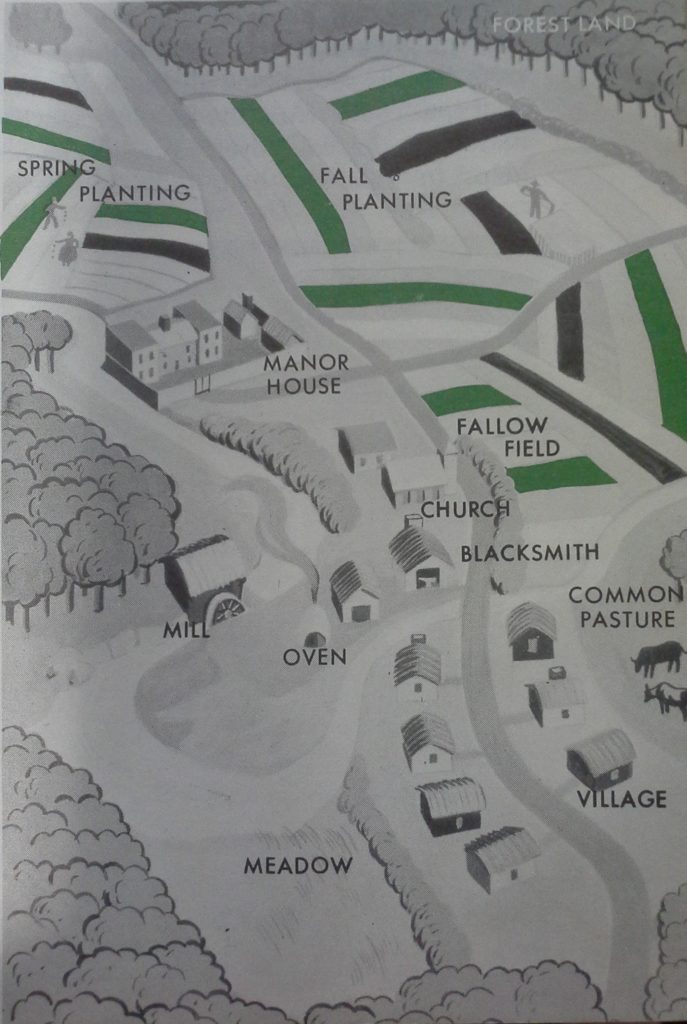
The manor house is the lord’s home. The manor house where you live with your parents and your brother and sisters is not large. The whole of it would fit easily within the inner court of the great castle where lives the rich and powerful noble whom your father visited last year. Largest and most frequently used of the rooms in the manor house is the hall. Here the manorial court meets. Here your father entertains the occasional guests whose visits help to break the monotony of life on the manor. Here all who live in the manor house eat their meals at long tables made of boards set on trestles. (Trestles are braced supports like saw horses.)
For each meal, the house servants, who are serfs, set up the tables in the form of a large “T”. Your family and any guests sit at the table which forms the head of the T. Green rushes are spread on the floor in place of rugs and your father’s hunting dogs nuzzle among them for bones and bits of food dropped or tossed from the tables. Your hunting knife and a wooden or horn spoon are your table utensils.
The huge fireplace at one side of the hall is a great comfort. What if the smoke from it does sometimes fill the hall? The heat that comes from the fireplace is what matters in this cold, drafty place. The fire helps to light the hall, too. Sputtering candles and flickering torches give but little light and the narrow windows, covered with coarse oiled cloth, do not help much. In the dim light you can scarcely see the faded tapestry which pictures a half forgotten hero, or the old shields hanging on the smoke stained oaken walls of the hall.
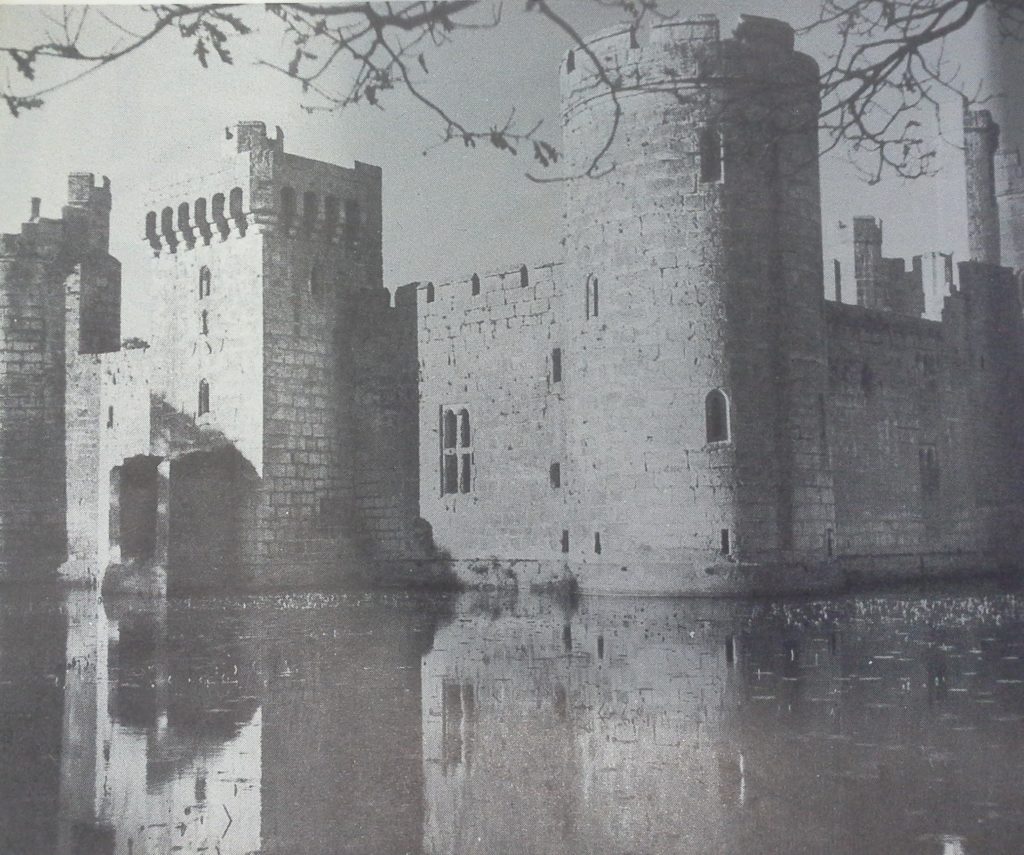
Sleeping rooms for your family, for the men-at-arms and for guests open off the hall. These rooms are cold and damp, except in summer. The beds are low, hard and the only covers are animal skins and coarse woollen blankets. Also reached from the hall is a tiny chapel with its altar and cross. Here the village priest or a visiting churchman holds services.
In the courtyard are the kitchen house, the great woodpile and a building where servants sleep. Here, too, are a well, stables for horses and other livestock, and the haymow.
The manor house serves as the village fort. Most manor houses are designed to withstand enemy attacks. The largest and most heavily fortified are known as castles. Your father’s manor house is protected on two sides by a deep, swift flowing stream. A wall of heavy logs about twelve feet high protects the other two sides. At night the heavy oaken gate in the wall is closed and barred with two massive beams. Over the gateway swings the alarm bell which, in times of danger, warns the people of the Village to hurry with their livestock to the safety of the manor house yard. Sometimes the ringing of the bell has given warning of an attack by outlaws who haunt the dark woods. Once it was rung to warn of the approach of an unfriendly lord and his soldiers.
Villeins and serfs live in rude houses. Your manor house is a palace compared with the little cottages where the villeins and serfs live. Some of these cottages have stone walls, while others are built of wood. Some have fireplaces and squat chimneys of stone. In cottages without fireplaces, the fires burn on the dirt floors in the centre of the only room and the smoke finds its way out through holes in the roofs of thatched straw. Windows, if covered at all, are closed with heavy wooden shutters or with oiled cloth. You once talked with a visitor from far off Rome who told about a wonderful material through which one could see as if it were still water. “Glass,” he called it, and claimed it would let in the light but shut out the wind. You mean to have glass in the manor house when you are lord, but such material is too costly for the common people.
Cottages cluster around the village mill and forge. The one room cottages are huddled along the roadside. The road comes out of the forest, crosses the stream on a log bridge and continues through the pastures and farm lands before vanishing again into the forest. Near the bridge stands the mill. The swift current drives the great water wheel which turns the heavy polished stones that grind the grain into coarse flour. Not far from the mill is the forge. Often you have watched the blacksmith heat a bar of iron to a dull red glow and with his hammer beat the metal into tools, hinges and other useful things. It is a busy day at the forge when your father’s horses are shod. Sparks fly as the smith shapes the red hot horseshoes on his anvil. There is a sudden, loud hissing when he plunges the hot metal shoes into the tub of water to cool them.
Life on a manor offers little chance for advancement. Much as you admire the blacksmith’s strength and skill, you are glad that you will ride horses instead of shoe them. You being a gentleman’s son, will be trained in the use of arms and in managing the affairs of the manor. The son of a blacksmith is likely to become a blacksmith, just as the miller’s son will learn his father’s trade. The sons of most farmers become farmers. In fact, there is little opportunity for a young man to do anything but follow his father’s occupation — unless he should become a priest. Most of the villeins on your manor, for instance, are sons of villeins who farmed there in your grandfather’s time.
Farmers work together in the fields. Except for the few men with special trades, most of the men living on your father’s manor till the soil. Throughout the growing season the farmers labour from dawn till dark in the big fields that lie on both sides of the road and extend to the edge of the forest. Usually each farmer cultivates several strips of land, depending on the arrangements with your father. These narrow strips do not lie side by side but are scattered among the three large fields of the manor. This is done so that each farmer will have a share of the best land as well as a share of that which is less fertile. Each farmer gets the yield from his own strips, but the work is done co-operatively. The farmers bring their work animals, farm tools and work together on all strips including their own.
Farm labour is hard and agriculture crude. You do not envy the farmers. You would not want to guide the heavy, clumsy plow drawn by oxen or cows, nor would you want to work the hard soil with a wooden shovel or fork. But these are the best farm tools most farmers have, for iron is expensive. Often seeds are not covered properly by the soil and so are carried off by the wind or eaten by birds. Moreover, the only way the farmers can keep the soil fertile is to let it rest part of the time. Each year one of the three fields of farm land is left unplanted. By allowing the strips in each field to lie fallow, or to be idle, once every three years, the land’s fertility is restored. To raise enough food for the manor under such conditions four-fifths of the people have to be full time farmers. Villeins and serfs, then, toil without ceasing; men and women of thirty-five are already worn and bent from their labours.
Food is scanty and monotonous. The best the villains and serfs can hope for in the way of food is a slice of pork, an occasional chicken, duck or goose and ale or thin, sour wine. If a cow or ox dies of old age or overwork, there is coarse, stringy beef. Careful farmers salt as much meat and fish as they can in order to keep it from spoiling.
Most of the time the inhabitants of the manor have only vegetables and bread to eat, or perhaps some cheese. (Wheat bread is usual in the warmer countries, but bread made from barley, cats or rye is commoner in cold climates. Potatoes and tomatoes, familiar in later times, are lacking.) There are fruits in season, such as apples and cherries, but only those that can be grown on the manor. The food served to you at the manor house, except for plenty of meat, game and fish, is not much better.

Life on a medieval manor changes little. Freeman and serfs know they are fortunate to have a good lord like your father. Hard and dull though manor life is, they accept it. At least they usually have the necessities of life — food, fuel, shelter and enough wool and hides from their sheep and cattle to make woolen or leather clothing. Serfs, of course, have no choice. Unlike slaves, serfs have some rights but they belong to the manor. There they must stay even should the manor be turned over to another lord.
The manorial system was part of the feudal system. So far we have been viewing life on a medieval manor (the manorial system) through the eyes of the lord’s son. We have found that the lord of the manor assigned land, kept order and provided protection for freemen and serfs. They, in return, gave him a share of their produce and services. Western Europe in the Middle Ages was dotted with such manors, each a complete unit in itself, producing its own food and clothing and having little contact with the outside world. The manorial system was only part of the landholding system in medieval Europe. Usually the lord of a particular manor did not own his land. Instead he was a tenant on land granted by some higher noble or powerful church man. For this land he owed services and payments to someone higher up. Lands so granted, from one noble to another, were called fiefs. The system of relationships growing out of the granting of fiefs was known as the feudal system.
Under the feudal system, lords of manors had obligations to higher nobles. The tenant, or holder of a fief, was called the vassal of the overlord who had granted him the land. Chief among the duties of the vassal to his overlord were military service and loyalty. In an age of constant warfare, much of the time of feudal nobles was taken up with fighting. When the overlord required it, the vassal was obliged not only to offer his own services in battle but to provide men at arms as well. In fact, the whole noble class in western Europe in the Middle Ages was a warrior class which received pay for its services in land instead of money.
Vassals had other duties, too. Should the overlord be captured in battle, his vassals had to contribute to his ransom. Other heavy expenses, such as the costs of a big wedding for the overlord’s daughter or of entertaining the king or some great noble, had to be borne in part by his vassals.
These feudal duties may seem simple and clear-cut, but often they were not. A lord might hold several fiefs, each from a different noble. He therefore was the vassal of each of these nobles. If two of these overlords should wage war against each other, what would he do? He owed military service and loyalty to both. If he fought for one, he broke his pledge to the other. If he fought for neither one, he broke his pledge to both. You can see how confusing feudal obligations could be and what trouble they could cause.
Knighthood grew out of the feudal system. All sons of noblemen hoped to become knights, but it was an honour that no one inherited — it could not be “handed down.” Even the son of a king had to earn it. Some young men won knighthood on the battlefield by their bravery and skill, just as soldiers in modern times have sometimes been made officers in the midst of battle. More often, however, men prepared for knighthood, just as men today prepare themselves to become officers in the armed forces.
In time, preparation for knighthood became quite elaborate. It began when a nobleman’s son was eight or ten years of age. Often he was sent to live with another nobleman as a page. There he learned good manners by waiting upon people of high rank and observing their customs. When he became older and strong enough to handle weapons, he became a squire. As a squire, he had to care for the nobleman‘s weapons, armour and look after the horse which his master rode in battle.
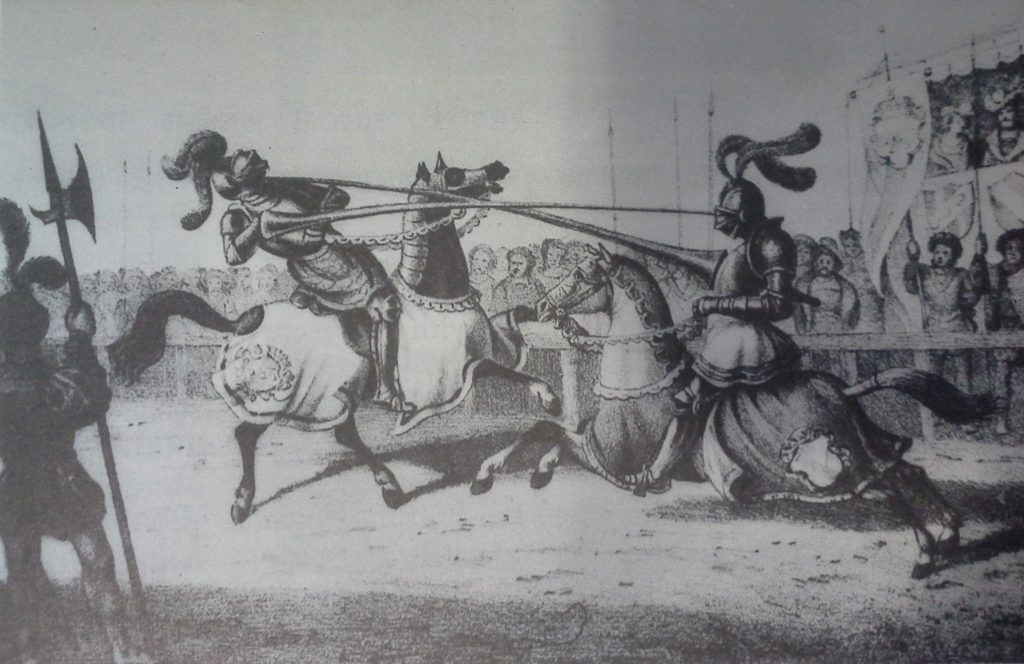
Under the nobleman’s critical eye, the young squire learned how to use weapons. This took strength and years of practice. Imagine going into battle weighted down with chain mail or with the plate armour the knights wore in the later Middle Ages! Imagine how difficult it would be, while riding a galloping horse, to strike squarely with your lance the helmet of a fast charging rider hurtling down upon you with his spear leveled at your helmet!
Before a man could win the right to wear the long sword and the spurs of knighthood, he had to prove his good manners and his skill in riding a horse and using weapons. Only then could the king or some high ranking noble make him a knight. The ceremony of knighting was an impressive affair and often took place before a large crowd of knights and their ladies. The knight to be kneeled before the noble, who lightly tapped the worthy man across the shoulders with a sword. On his part, the would be knight promised to be brave and loyal. Sometimes the candidate for knighthood spent the night before in church, praying that he might prove worthy of this great privilege. Beside him in the church were the sword and armour he would wear when knighted.
Knighthood stressed good conduct. Knights were bound to a code of conduct which has been called chivalry, a word that comes from the French word for horseman, Chevalier and is a first cousin to our word cavalry. Loyalty, courage and politeness were among the First of the rules that governed a knight’s conduct. The knight who was rude, who boasted, who broke his promises, or who was cowardly in battle or tournament was disgraced.
This code of conduct, however, applied largely to dealings between nobleman; it seems to have had little effect on knights’ attitudes toward people of lowly birth. Moreover, knighthood glorified military power and the use of weapons and thus widened the gap between the higher and lower classes. Nevertheless the age when knighthood was in flower was a great advance over the untamed rudeness of the earlier Middle Ages. The code of chivalry taught nobles to show courtesy and respect to each other, to their womenfolk and even toward their defeated foes. In time the idea of chivalry toward one’s social equals was enlarged to include kindness and courtesy toward everybody.
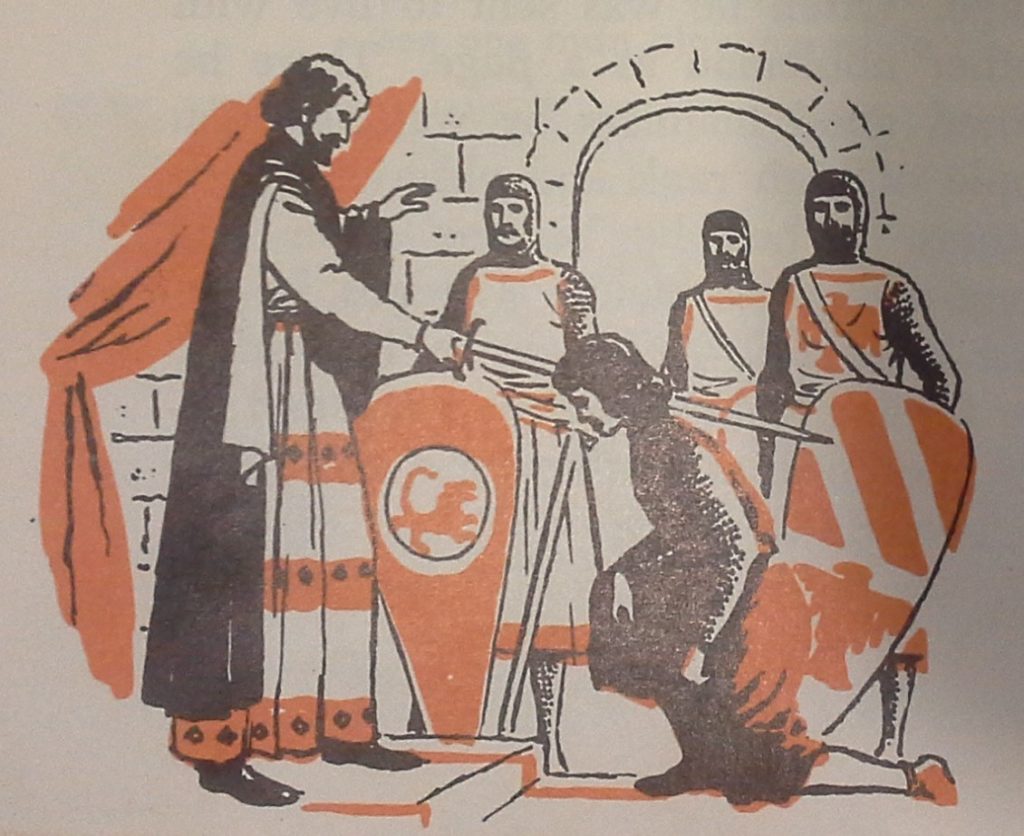
2. Why did the Feudal System Develop?
You may well ask the question: Why did the feudal system develop throughout western Europe during the early Middle Ages? The answer is to be found in the conditions which existed after the decline of Roman power.
The decline of Roman power was followed by centuries of disorder. The barbarian hordes which overran the Roman Empire broke down its well-ordered system of government. No sudden or complete change took place in everyday life. The barbarians conquered and plundered, yet they also adopted some Roman ways of living. Furthermore, most of them became Christians and had great respect for the Church. Nevertheless, the unity of the Roman Empire was shattered. Instead of continuing under a single government, western Europe fell piecemeal into the hands of numerous Teutonic chieftains.
These local rulers did not have enough talent to carry on the Roman kind of government. Furthermore, they lacked trained officials to carry out their will or to collect the regular taxes on which the Roman government had depended. Such taxes had made it possible for the Roman government to maintain a standing army to back it up at all times. Teutonic soldiers were unpaid, and went home when a war was over. Certain duties of government, such as the care of the sick and needy, were taken over by the Church and other duties were neglected. Under these circumstances roads and bridges were not kept in repair. Trade declined greatly because travel was unsafe. Towns became fewer and smaller. In short, for several hundred years civilization in western Europe lost ground. The makings of a new civilization were present, but it was not to develop for hundreds of years to come.
The Franks established control over a sizable kingdom. Among the barbarian tribes that invaded the old Roman Empire were the Franks, who came from east of the Rhine River in what is now Germany. The Frankish kings established a kingdom which included roughly the same area as the old Roman province of Gaul. They ruled not only the Franks but other Teutonic peoples, as well as the former Roman inhabitants. To the land which they settled, the Franks gave the name of France, meaning the land of the Franks.

In their new home the Franks found various traces of Roman civilization and they picked up many of the customs of the people they had conquered. An able Frankish leader named Clovis, who had married a Christian princess, became a Christian himself in 496 A.D. From that time forward, with a few important exceptions, Frankish rulers and Catholic churchmen helped each other. The kings protected the clergy and the property of the Church in France and the churchmen used their learning and influence to assist the rulers.
Some Frankish kings were much more powerful than others. The kings of this half Roman and half Teutonic kingdom in France, however, had only about as much power as they could win by their own efforts. The warlike Franks seemed to respect only one kind of ruler — one who was strong enough to force them to obey. After about 250 years, the ruling family of the Franks became so weakened that it was pushed aside by a high court official named Pepin. Pepin was the son of Charles Martel, the Frankish leader who had turned back the invading Mohammedans at Tours in 732. In 751 Pepin got himself crowned king and so started a new ruling family.
Charlemagne greatly extended the land of the Franks. Although Pepin was an able soldier and a wise statesman, his son Charlemagne possessed these qualities to an even greater degree. Charlemagne’s success is indicated by the extent of the empire he ruled. On the map notice the areas controlled by the Franks in 768 when Charlemagne became their king. Then notice how much more land Charlemagne brought under his rule. All of what is now France and a considerably greater area east of France were included in his vast empire. Wherever Charlemagne went, he brought Christianity and encouraged the building of churches, monasteries and the spread of learning.
Charlemagne was crowned Emperor. Small wonder this Frankish king was known as Charlemagne, which means Charles the Great. Small wonder the learned men who read of the glories of ancient Rome believed that Charlemagne was the leader to restore the Roman Empire. On Christmas Day, 800 A.D., while Charlemagne was kneeling in prayer before the high altar in St. Peter’s Church in Rome, the Pope proclaimed him Emperor of the Romans and placed a crown upon his head. A Frankish writer of the day described this memorable event in these words:
It seemed good to both Leo, the Pope, and to the holy fathers who were in council with him, and to all Christian men, that they should name Charles, king of the Franks as Emperor. For he held Rome itself, where the ancient Caesars had always dwelt, in addition to all his other possessions in Italy, Gaul and Germany. . . .
Charlemagne’s coronation as Roman Emperor paved the way for the establishment of the Holy Roman Empire. The Holy Roman Empire lasted in central Europe until about 150 years ago, but it never was able to restore in the West the unity and power of the old Roman Empire.

Charlemagne strengthened law and order in his empire. History tells us of many men who could conquer but could not govern what they had conquered. Charlemagne, however, governed firmly and wisely. To obtain the funds which he needed, Charlemagne relied in large part upon the income from the royal lands. The men who managed these royal farms or manors were required to present detailed accounts to the king. To rule the many parts of his empire, Charlemagne had to depend on high ranking nobles known as counts and dukes. These local officials enforced the laws, kept the peace, provided soldiers when needed and collected taxes or fees. Charlemagne tried to make the counts loyal to him. He wanted them to become “the hand and voice” of the king in governing the empire.
Charlemagne was too shrewd to let these high nobles rule without constantly checking on their loyalty and efficiency. So he sent other officials, the “messengers of the master,” to inspect the work of the high nobles. Because the “messengers” were sent to different parts of the empire each year, there was little chance for them to plot with local nobles against the Emperor.
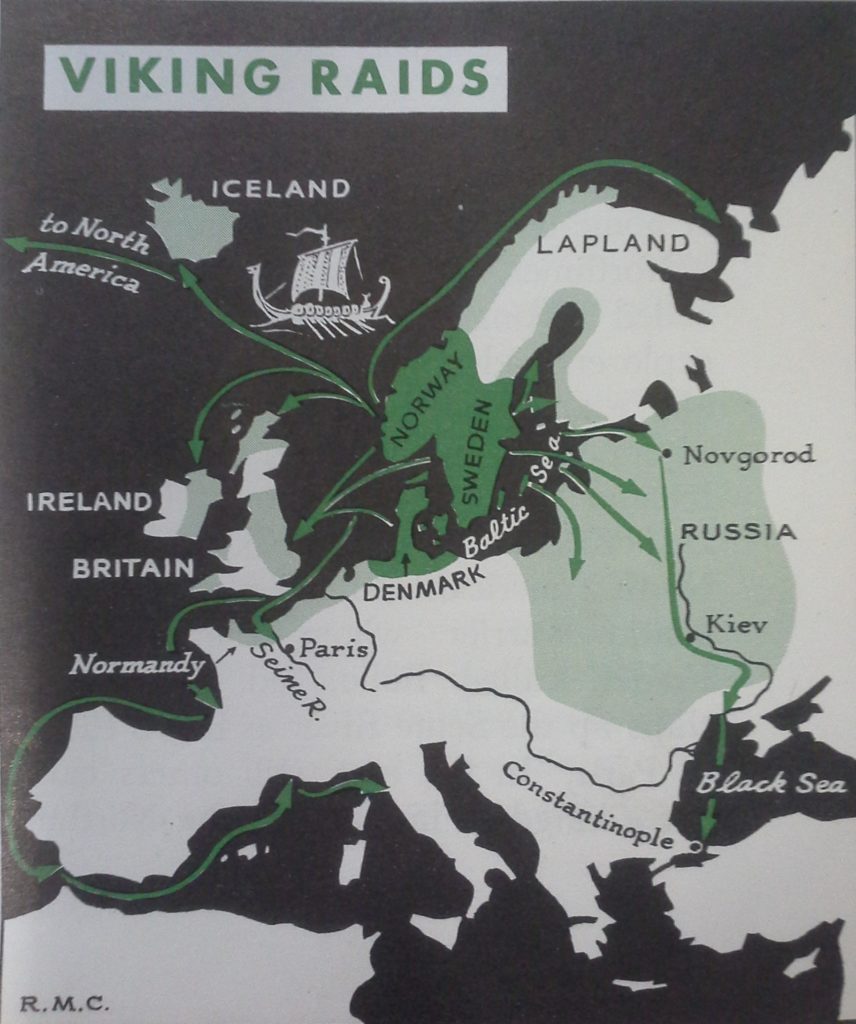
Charlemagne encouraged learning. Though this great ruler of the Franks could write little more than his own name, he did much to encourage education. Schools were founded to train boys to become priests. In fact, Charlemagne maintained a school at his palace for the young sons of great nobles. As teachers in this school he brought together a group of learned men, among them Alcuin, the outstanding scholar of the time.
Charlemagne’s empire was divided into three parts. After Charlemagne’s death, his empire, like that of Alexander the Great some 1100 years earlier, quickly fell apart. Both empires had been built by strong, energetic rulers. Without wise leadership and firm control, both broke into fragments. Charlemagne’s only surviving son, Louis the Pious, arranged to divide the empire among his three sons at his death. One son received most of what is now Germany. Another was given most of what is now France. A middle area, corresponding roughly to modern Belgium, Holland, Alsace and Lorraine, Switzerland, and northern Italy, along with the title of Emperor, went to Louis’ eldest son.
Soon the three sons quarreled. The middle kingdom between France and Germany was joined to the eastern or German kingdom. The western portion of the empire remained independent and in time became the kingdom of France.
The broken empire split into still smaller pieces. If the breakup of Charlemagne’s empire had resulted in strong French and German kingdoms, law and order might still have been maintained throughout western Europe. In France, as well as in Germany and Italy, the government became weak and inefficient again, as it had been before Charlemagne. Funds and trained officials were lacking. Such weakness gave the counts and other nobles an opportunity to make themselves practically independent of kings and of central control. Western Europe was broken up into small areas controlled by local nobles.
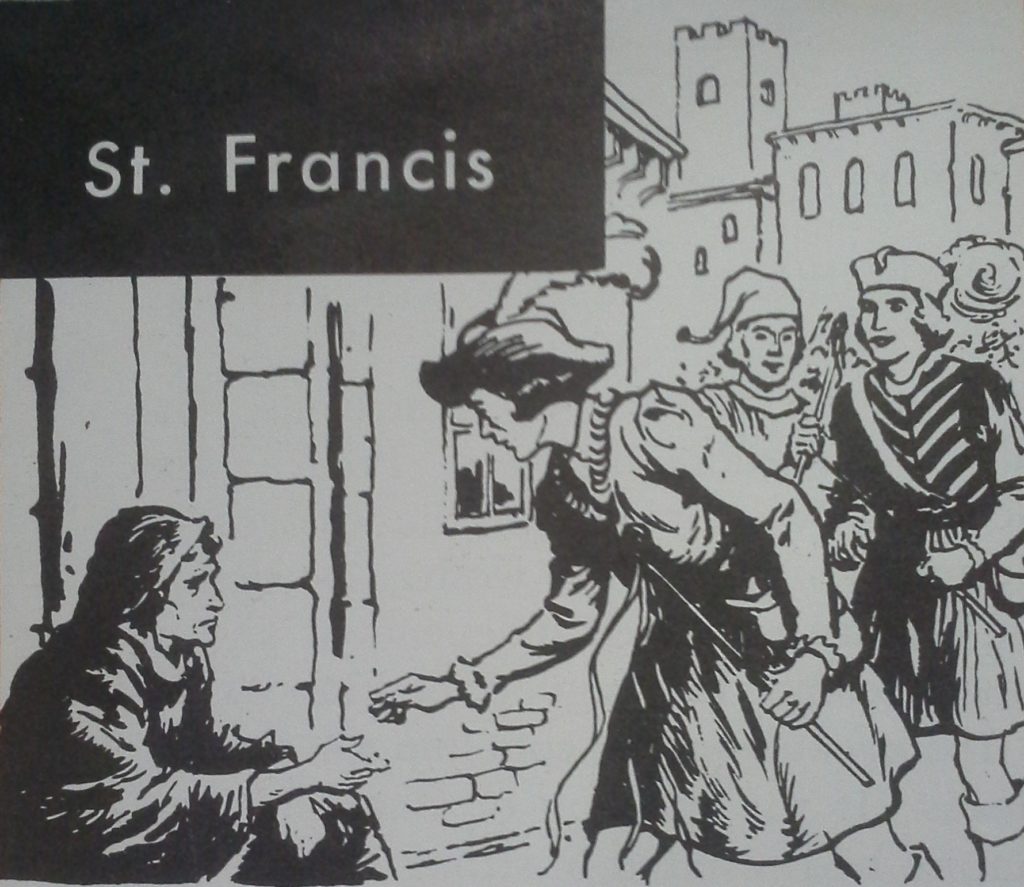

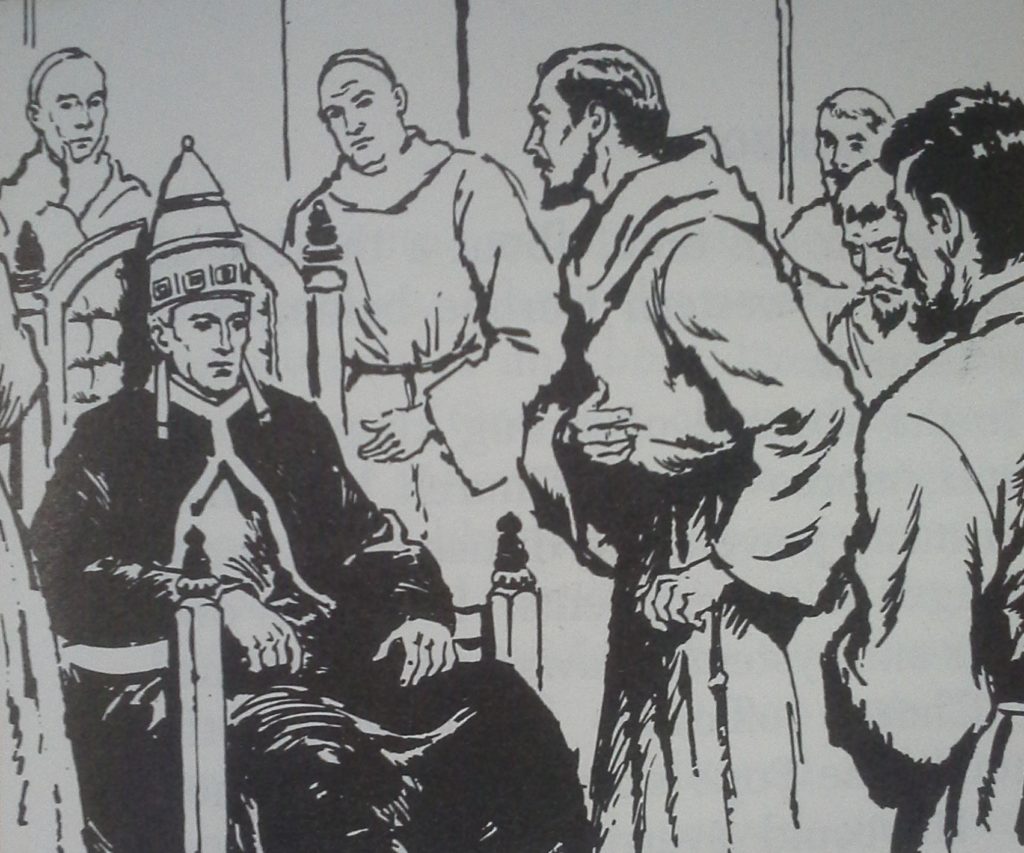
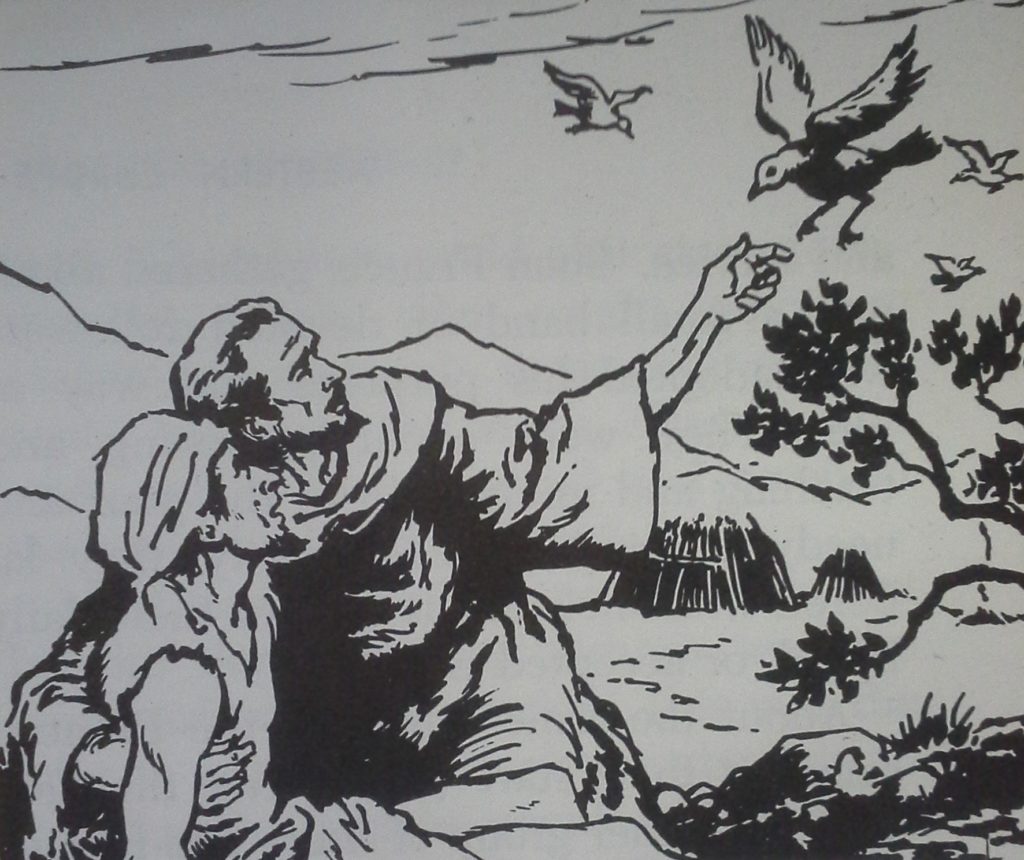
Invasions of the Northmen added to disorder and insecurity. New invaders from northern Europe made matters even worse. In what we today call Denmark, Norway and Sweden there lived tall, broad shouldered Northmen. Their gods were gods of battle, their heaven a place where dead heroes happily fought all day and feasted all night. These blond, blue eyed warriors despised a quiet life and a peaceful death — a Cow’s death they called it. They were rugged fighters with weapons as good as the best in Europe and they knew well how to use them. Their light and narrow ships with the wooden dragon in the prow were as much at home on the seas as so many sharks.
Northmen who took to the sea were called Vikings. They were explorers, adventurers and traders, but above all, pirates and plunderers. Their explorations took them to Greenland and Iceland. One Viking leader, Leif Ericsson, visited North America. Others, including a gigantic warrior whom the frightened French called Rollo, led their dragon ships up the Seine River as far as the city of Paris. In the east, still others carved out a kingdom in Russia. The Northmen robbed, burned and then settled the shores of France, England, Scotland and Ireland. In churches in every part of the Christian world the kneeling people prayed, “From the fury of the Northmen, good Lord deliver us!”
People turned to local leaders for protection. You can easily imagine the confusion in western Europe after Charlemagne’s empire broke up. Nobles fought each other and took the law into their own hand as the king’s power waned and Viking raiders added to the chaos. Life was conducted according to
” . . the good old rule . . . the simple plan…That they should take who have the power, And they should keep who can!”
Under such conditions people turned to the nearest strong man for protection. Distant kings or emperors could do little for them because help had to be immediate to be of any value. There was no such thing as national spirit or patriotism to bind people together.
The feudal system, then, grew chiefly out of the unsettled conditions through out western Europe. In the absence of strong central government, peasants turned to local lords for protection and vassals depended on overlords for order. Sometimes kings granted fiefs on the frontiers of their realms to lords who were expected to keep out invaders. The feudal system offered some security in an age of warfare, confusion and brutality.
3. What Was the Place of the Church and Churchmen in the Middle Ages?
Father Bernard trudged along the narrow forest road, his long robe of coarse brown cloth flapping in the brisk autumn wind. Sandal-shod, he unconsciously avoided the deep puddles as his lean body, toughened by years of tramping in all sorts of weather, pressed onward. Father Bernard was a friar, a traveling priest whose life was devoted to the service of God and man.
Father Bernard’s hands were as accustomed to caring for a sick person or holding a plow in its furrow as they were to turning the pages of his prayer book and to making the sign of the Cross. For this man was not only a priest; he was a doctor, teacher, bringer of news and good friend, both to shut away people in remote villages and to poor people in the towns. In return for his services, Father Bernard asked nothing but plain food and a place in which to sleep.
St. Francis and St. Dominic founded organisations of friars. Father Bernard’s brown robe marked him as a Franciscan friar, a follower of St. Francis of Assisi. St. Francis is one of the noblest and most lovable characters, not only of the Middle Ages but of all time. Born into a wealthy family, as a young man he turned from a life of aimless pleasure to one of poverty, seIf-denial and service. Soon Francis gathered about him a small band of devoted followers who adopted his purposes and way of life. They went about preaching and teaching and ministering to the poor and needy. Giving up all property, they laboured with their hands to earn their daily bread, or accepted charity.
About the same time that the Franciscans got their start (soon after the year 1200), another group of friars was formed by a Churchman named Dominic. The movements begun by St. Francis and St. Dominic grew rapidly and resulted in the great Franciscan and Dominican Orders (religious groups) of the Roman Catholic Church which exist to this day.
The Roman Catholic Church held an important place in the lives of the people. The Franciscan and Dominican friars were but a part of the powerful organization of the Catholic Church. The Catholic Church, you remember, was the only church in western Europe in the Middle Ages. At a time when there were no strong nations, the Catholic Church supplied the chief bond which held the people of western Europe together. In fact, the Church became very much like a state with its own officers and its own laws.
The Pope, as head of the Church, wielded great power and influence. At the head of the Church was the Pope, who was also Bishop of Rome. Gradually Popes acquired more influence and authority. Among them were strong Church leaders such as Gregory the Great, who was Pope from 590 to his death in 604. Gregory helped to maintain order throughout Italy, built up the organization of the Church and strengthened the authority of the Pope. Under Gregory, as well as other Popes, courageous missionaries spread the faith of the Church, particularly among the barbarian tribes in Britain and Germany. The alliance between churchmen and the Frankish rulers further increased the power of the Popes. Generous gifts of land added to the wealth and influence of the Church. In time, about a third of all the land in western Europe belonged to the Church.
In the absence of strong kings or emperors, moreover, the Church had taken over many powers and duties that usually belonged to governments. It had its own courts and system of laws which governed all Church officials. As head of the Church, the Pope exercised great authority. He could overrule the decisions of any Church court. In some cases he actually overruled a king. Christians in western Europe during the Middle Ages considered the Pope not only the supreme head of the Catholic Church, but greater than any king; for they believed him to he God’s chief representative on earth.
The Church was served by a large body of clergy. Under the Pope’s authority there were large numbers of clergyman. The chief assistants of the Pope were the bishops who were located in large cities and towns. Each bishop presided over a territory known as a diocese. Under the bishop were all the village or parish priests in the diocese. In some instances several dioceses were combined under an archbishop. Certain bishops and other high ranking clergyman called cardinals elected the new Pope when the former Pope died.
The bishops’ churches — the cathedrals were larger and more beautiful than the village or parish churches. Bishops often controlled much land and property, needing soldiers to protect their holdings and to enforce laws. High ranking Churchmen granted portions of the lands under their control to noblemen.
Monasteries were important in medieval life. In addition to the clergyman just described, there were the monks who lived in monasteries and nuns who lived in convents. Monasteries in western Europe, you will recall, dated back to the barbarian invasions. Soon after the year 500, St. Benedict founded the monastery at Monte Cassino in Italy. The rules which St. Benedict laid down for the monks within this monastery were widely adopted in other monasteries. There the monks, under the supervision of an abbot lived in security and peace. One day of worship, prayer and labour followed another. Schools were conducted, libraries were preserved and books were laboriously copied by hand. Women who wished to withdraw from the world could enter convents to be come nuns. They followed strict rules and they worshiped, prayed and worked as did the monks in the monasteries.
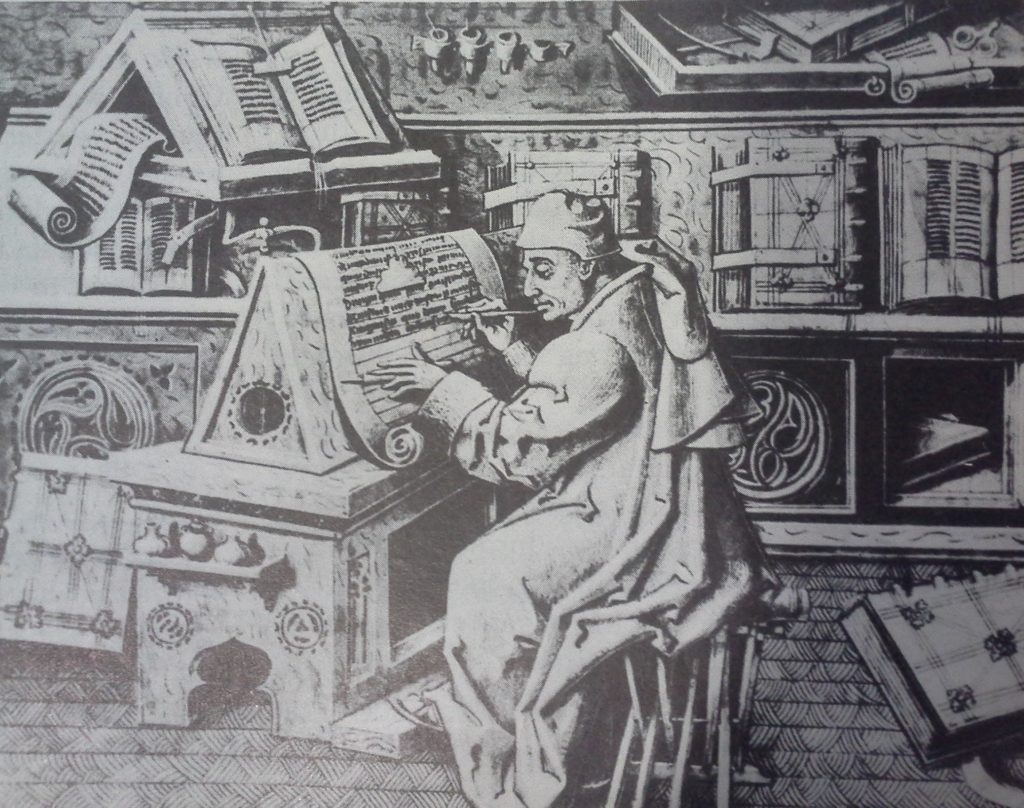
The clergy were drawn from different classes. You have already learned of the wide gap between nobles and serfs in the Middle Ages. A serf’s son was almost sure to be a serf, a noble’s son to be a knight. The sons of villeins and serfs however, might become parish priests. Those of outstanding ability might rise to very high positions in the Church and might even become Popes.
The clergy had many privileges. Churchmen in the Middle Ages had many privileges. They paid no taxes to the king’s government on the property owned by the Church. Indeed the Church itself collected a tax called the tithe, Church men were free from military service and if accused of wrongdoing could be tried only in Church courts by other clergymen. Churchmen could also give protection to people who sought sanctuary (safety) in a church, monastery or convent. Not even the king’s officers could arrest one who had asked and received the protection of the Church.
Most feared of all the powers exercised by the Pope and the bishops was the power of excommunicution. This was the right to cut off a person’s membership in the Church. People believed that anyone who was not a member of the Church was forever denied salvation, excommunication was a fearful punishment. To force some stubborn king to come to terms, the Church might even place a whole country under an interdict. This meant that no church services could be held, a very serious matter for people with deep religious faith.
The clergy possessed many responsibilities. What did the clergy do in return for these privileges and powers? It would be hard to say what they did not do. If you were in want, the priest or a monastery would give you food, clothing and shelter. If you were ill, the nearest Church hospital would take you in, or a friar might care for you in your house. If you were travelling, a monastery would gladly give you a night’s lodging. If you were eager to learn, monks often were the only teachers available.
In addition, the churchmen tried to maintain peace among the warlike nobles by establishing the “Truce of God.” From Thursday evening until Monday morning and on holy days, there was to be no fighting. During the peaceful days of the weekend, people could go about their affairs without too much danger to themselves and their property.
The Truce of God, though frequently violated, was an important step toward restoring order during a time when only the Church was strong enough to enforce such a rule.
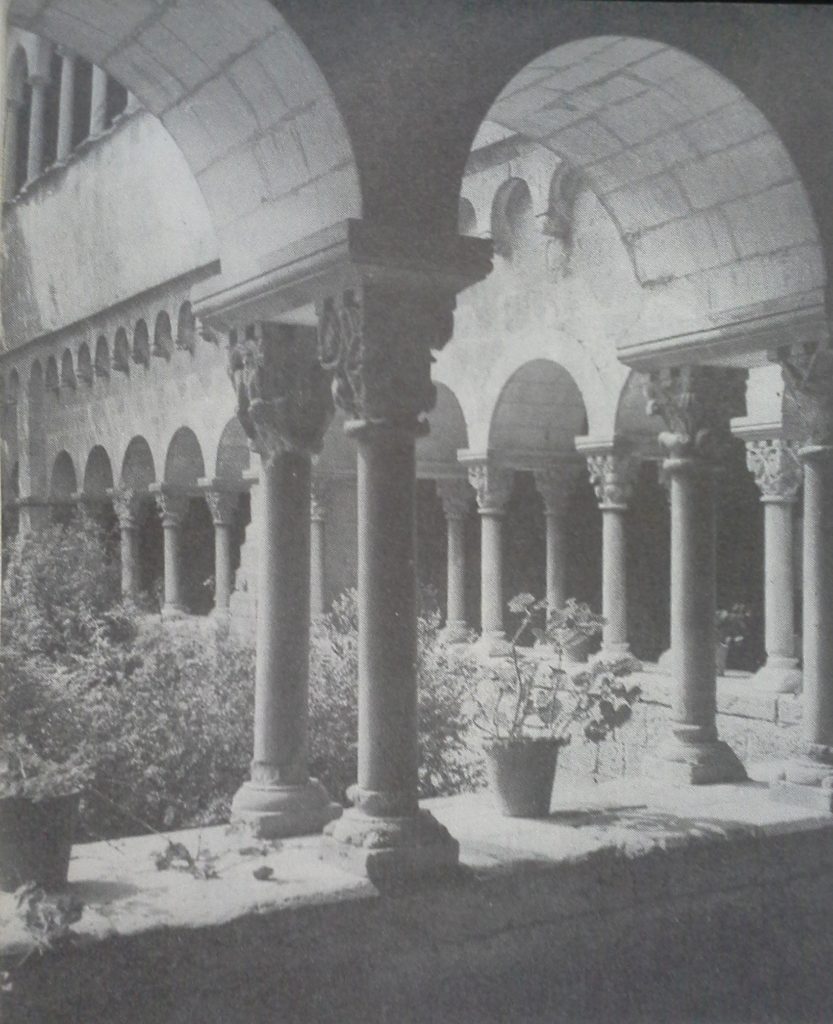
The clergy administered the sacraments. The most important duty of the clergy, however, was to administer the sacraments. The sacraments during the Middle Ages could be described in these terms:
Baptism, by which a person was dedicated to a Christian life.
Confirmation, when a baptized person of his own will publicly acknowledged his membership in the Church.
Penance when a person confessed his sins, asked forgiveness, did some act to show he was truly sorry and promised to try to do better in the future.
Extreme unction, given by priests to persons near death, as a sign that the person had been cleansed and forgiven of all his sins.
Holy Communion or Eucharist enabled a Christian to share in the saving grace resulting from Christ’s sacrificial death. This sacrament was usually administered during the ceremony of the Mass, attended by Christians on Sundays and certain holy days.
These first five sacraments were part of everyone’s life. In addition there were two others — holy orders or admission to the clergy and matrimony or marriage.
Today the sacraments are still administered by the Roman Catholic Church, much as during the Middle Ages. Several of the sacraments, some in slightly different form, are also administered by Protestant clergy.
During the Middle Ages, then, the inflence of the Church was powerful and far-reaching. In a time when kings were weak and government disorganized, the Church was the strongest single organization in western Europe. Christians attended the same kind of Church service and received the same sacraments. The clergy occupied positions of influence and ministered to the wants of the people. It would be difficult to overestimate the importance of the work of the Church in preserving civilization.
